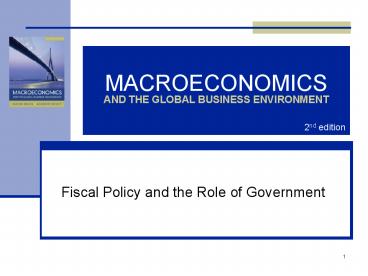MACROECONOMICS AND THE GLOBAL BUSINESS ENVIRONMENT - PowerPoint PPT Presentation
Title:
MACROECONOMICS AND THE GLOBAL BUSINESS ENVIRONMENT
Description:
... debt issued in a particular fiscal year. Debt: accumulation ... Primary balance: difference between revenue and spending not including interest on debt ... – PowerPoint PPT presentation
Number of Views:58
Avg rating:3.0/5.0
Title: MACROECONOMICS AND THE GLOBAL BUSINESS ENVIRONMENT
1
MACROECONOMICSAND THE GLOBAL BUSINESS ENVIRONMENT
2nd edition
- Fiscal Policy and the Role of Government
2
Key Concepts
- Debt and deficits
- Fiscal Finance
- Debt versus taxes
- Intergenerational equity
- Debt sustainability and the primary surplus
3
Government Spending
- Types
- Consumption of goods and services
- Investment
- Transfer payments
- Considerable variation in spending
4
Fiscal Policy Components
- Financing
- Taxes
- Borrowing
- Others?
- Composition of Spending (G)
- Current goods and services
- Public investment
- Government Expenditures
- Spending transfer payments payment on debt
5
Government Spending of GDP, 2002
Source OECD online database
6
Looming Issues
7
Value of government spending
- Rationale for Government Role
- Market Failure Public Goods
- Markets are not allocating all goods efficiently
- Pareto Efficiency unable to make anyone better
off by reallocating resources without making
someone worse off - Public goods will not be provided by private
sectorlack of incentive - Redistribution
- Paternalistic view
- People will not always act in own best interest
- Subsidize education, force savings (retirement)
- Social Welfare
- Stabilization Policy (later)
8
Public Goods
- Goods produced in the market have two
characteristics rivalry excludability - rivalry ones use of good makes it unavailable
for others (e.g. if I eat the snickers candy bar,
you cant) - excludability those unwilling to pay do not have
access to benefits of product (e.g. if you dont
pay for the snickers candy bar, you cant have
it) - Public goods have characteristic of nonrivalry
and nonexcludability - Examples national defense, lighthouse, highways
- Degrees of nonrivalry nonexludability
(quasi-public goods like police and fire
protection) - Nonexludability characteristic creates a
free-rider problem no incentive to contribute to
cost - makes private production unprofitable
9
Level of Spending
- What proportion of GDP should be allocated to
public spending? - Merit of spending
- Sources of spending
- Taxation creates distortions
- Creates a wedge between value of labor and
availability of labor - May alter a firms decision to invest
- Deficit financing can have adverse economic
effects - Crowd out private investment
- Intergenerational transfers
- Unsustainable debt levels financial crisis
- Do benefits exceed costs (distortions)?
10
Laffer Curve
- Taxes collected Tax rate x Wage x N
- Two competing effects
- Tax rate x Wage is rising
- N is falling
- Eventually, tax collections will fall
Tax Revenue
0
100
Tax Rate
11
Government Borrowing
- Deficit debt issued in a particular fiscal year
- Debt accumulation of past deficits and surpluses
- Developed country trend increasing budget
deficits during post-WWII era with increased
government spending - Historically, deficits during wartime only
- Revenues have not kept up with expenditures
- Figure 10.13, 10.15, page 240
- Debt payments increasing portion of budget
- Table 10.3, page 242
- Primary balance difference between revenue and
spending not including interest on debt
12
Deficit
Debt
Debt
13
Debt
Debt
Surplus
14
Debt as a percentage of GDP, 2002
Source OECD Economic Outlook
15
Cost of Government Borrowing
- Intergenerational Redistribution
- Government effectively reallocates resources
between age groups - Running a deficit
- Unfunded pension programs with rising old-age
dependency - Developed countries younger generation will
receive fewer benefits for taxes paid - Figure 10.18, page 246
- Deficit financing uses up national saving
- Less saving for private investment
- Poorly managed public debt can create financial
crisis - Unsustainable debt accumulation
16
Generational Accounts
Present value of net tax payments (until death)
by different generations indexed by age in 1995
(Thousands ).
17
Recall Saving-Investment Model
Private Savings
Interest Rate
5
Investment
I0
Output
18
Deficit Negative Savings
Private Savings Government Savings
Private Savings
Deficit
Interest Rate
6
5
Investment
I1
S1
I0
Output
19
Dynamic ResponseSuppose savings increases with
the deficit
Private Savings Government Savings
Private Savings
Interest Rate
6
5
Investment
I1
I0 S1
I0 I1
S1
Output
20
Sustainability of Debt
- Debt sustainability debt does not rise relative
to GDP - Stable debt/GDP ratio
- Can continue to run budget deficits if
- GDP grows faster than or equal to growth in debt
- Increase in debt/GDP ratio arises from
- (1) ?interest on debt changes
- (2) ?GDP growth
- (3) ?primary deficit
- Budget balance primary balance interest
payments
21
Sustainability of Debt
- r real interest rate
- g real growth rate of GDP
- If r g, must have primary surplus
- If r
22
Intertemporal Budget Constraint
Year 2005 D(2005) G(2005) - T(2005)
Suppose debt is paid off in Year 2006
Year 2006 T(2006) G(2006) D(2005)x(1R)
Hence, taxes are higher in 2006
T(2006) - G(2006) D(2005)x(1R)
Year 2005 G(2005) T(2005) T(2006)-G(2006)/(1
R)
23
Spending in year 2005 must be supported by
current and future taxes.
24
Implications
- Countries with high debt must
- Default
- Run tighter fiscal policy in future
- Debt levels should vary across countries
- Purpose of spending (consumption versus public
investment) - Role of expected future liabilities (pensions)
- Intergenerational equity
25
Optimal Budget Deficits
- For what purpose is spending being used?
- Consumption
- Investment
- Cyclical considerations
- Recessions mean low tax collections, high payouts
- Should taxes increase during recessions?
- Distortionary effects of taxation
- Tax smoothing
26
Summary
- Government spending is a significant fraction of
economic activity - Role of government spending
- Financing
- Taxes, and their distortionary effects
- Deficits
- Effect of deficit spending
- Debt sustainability

